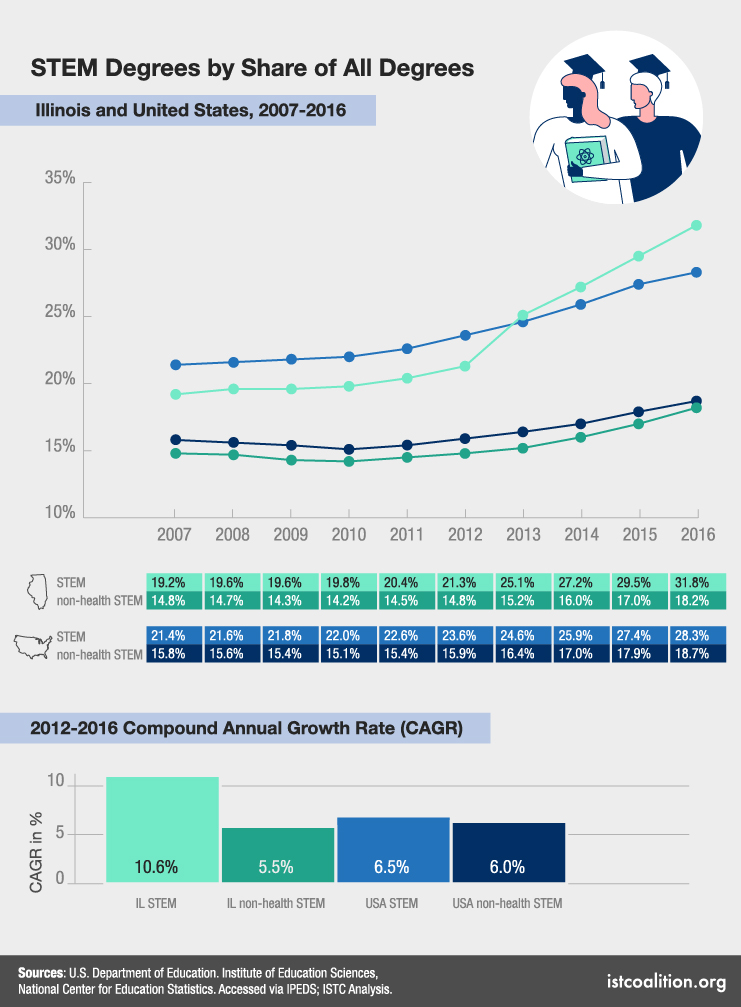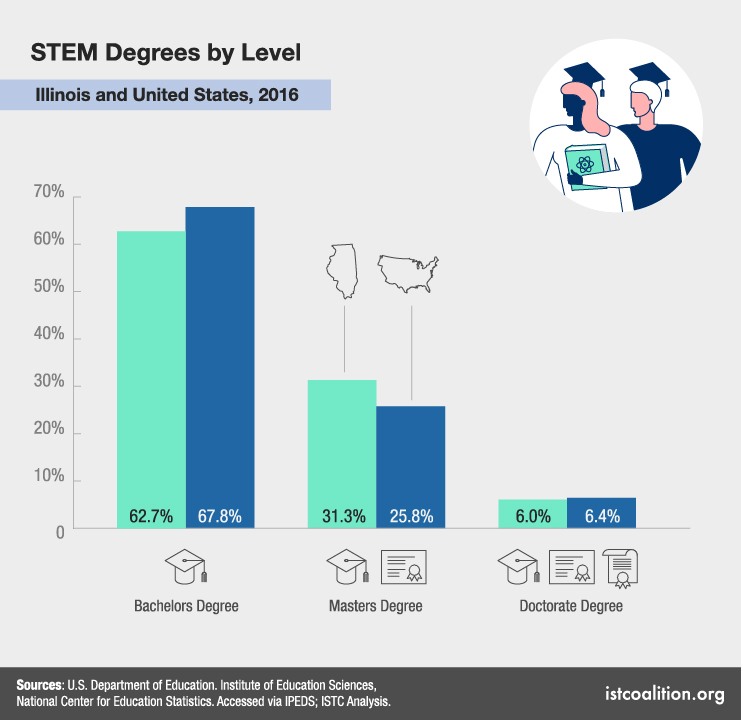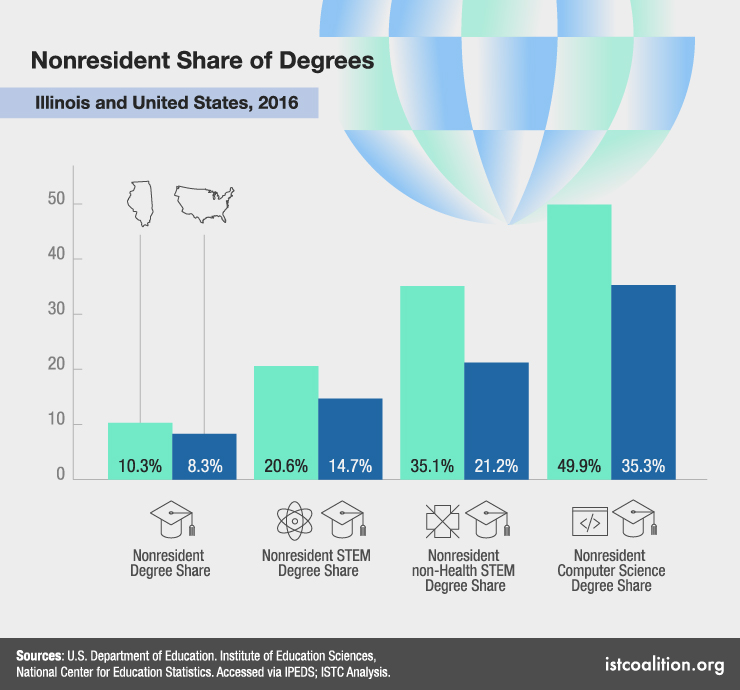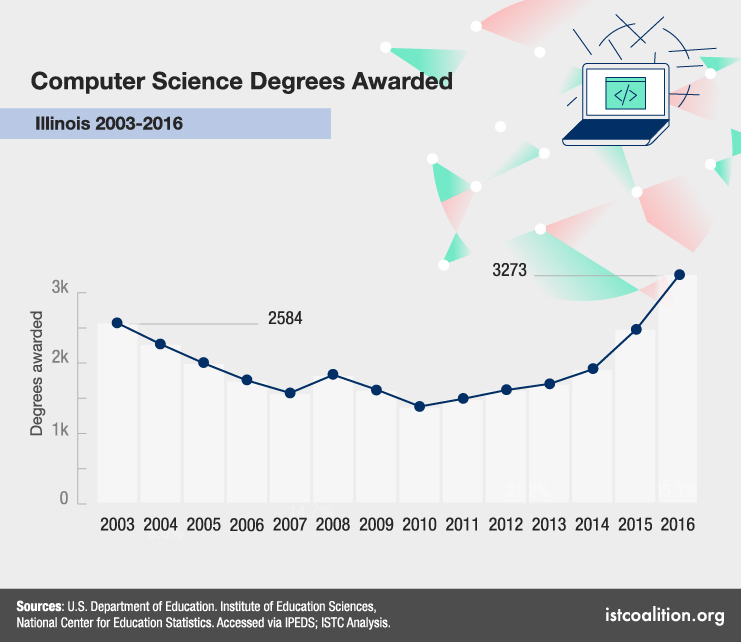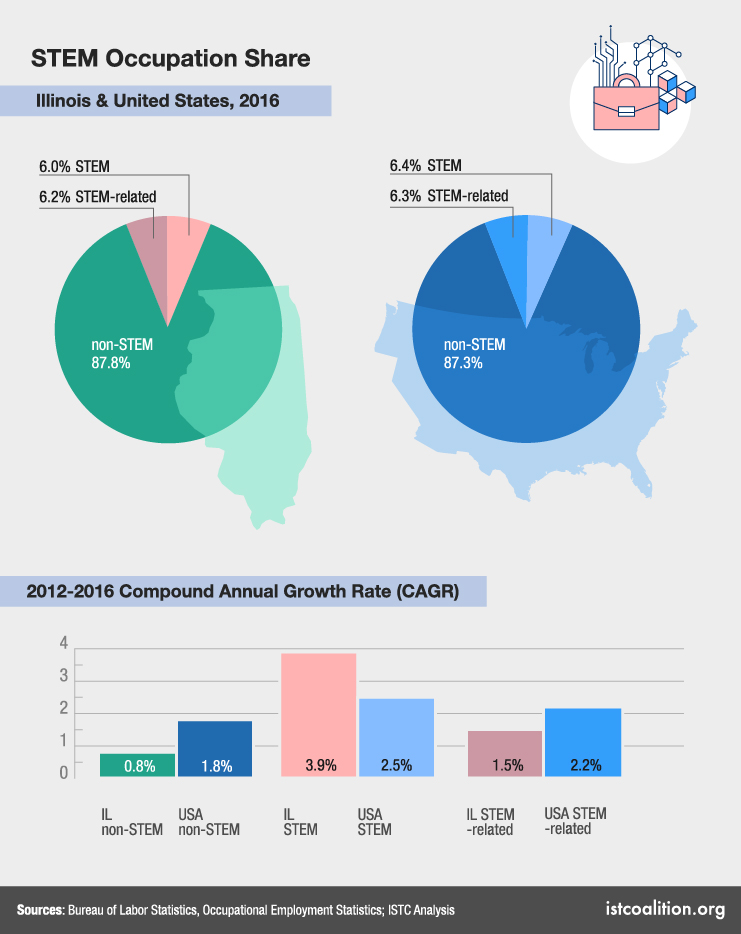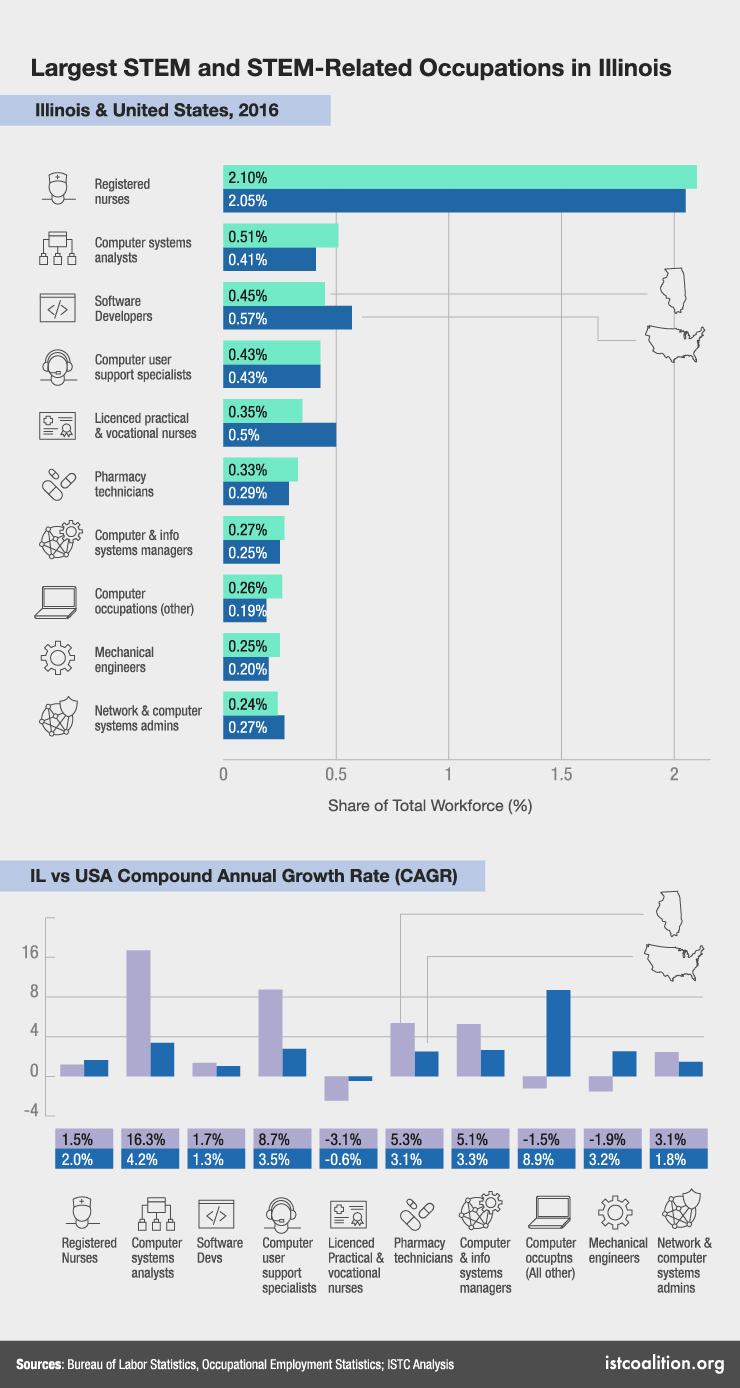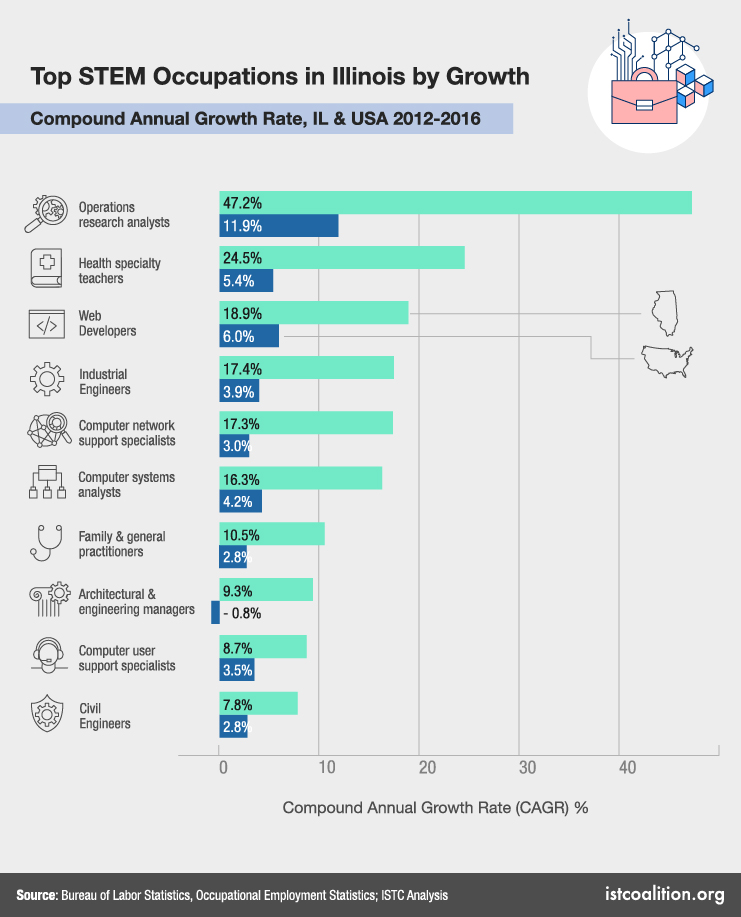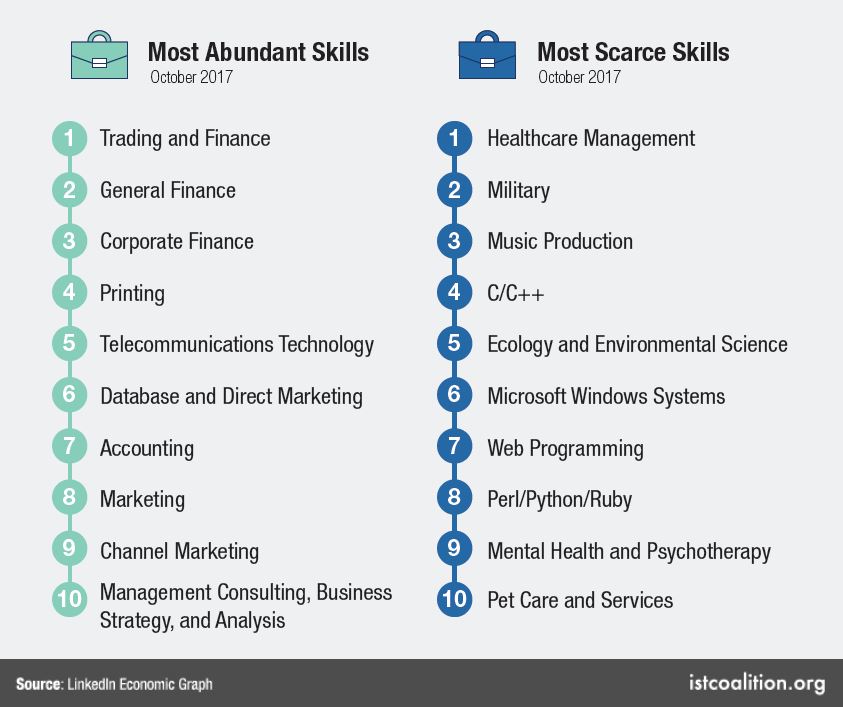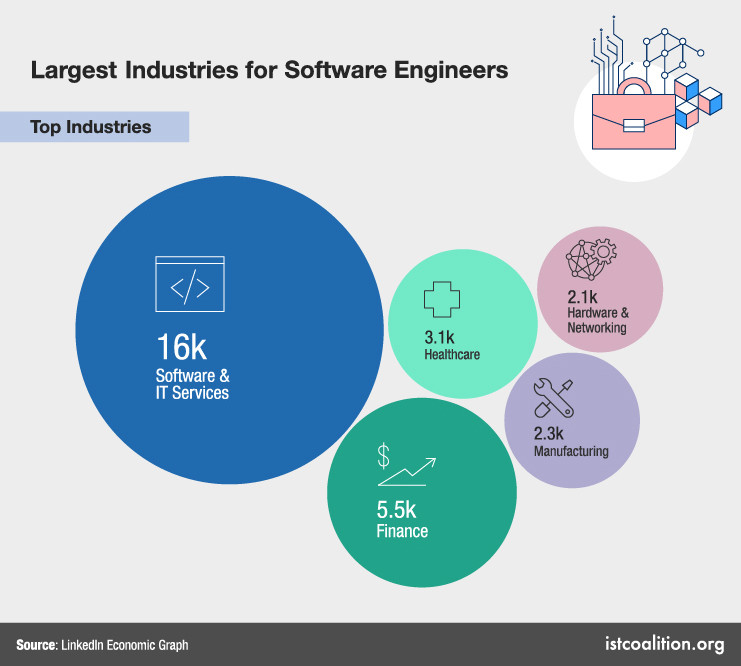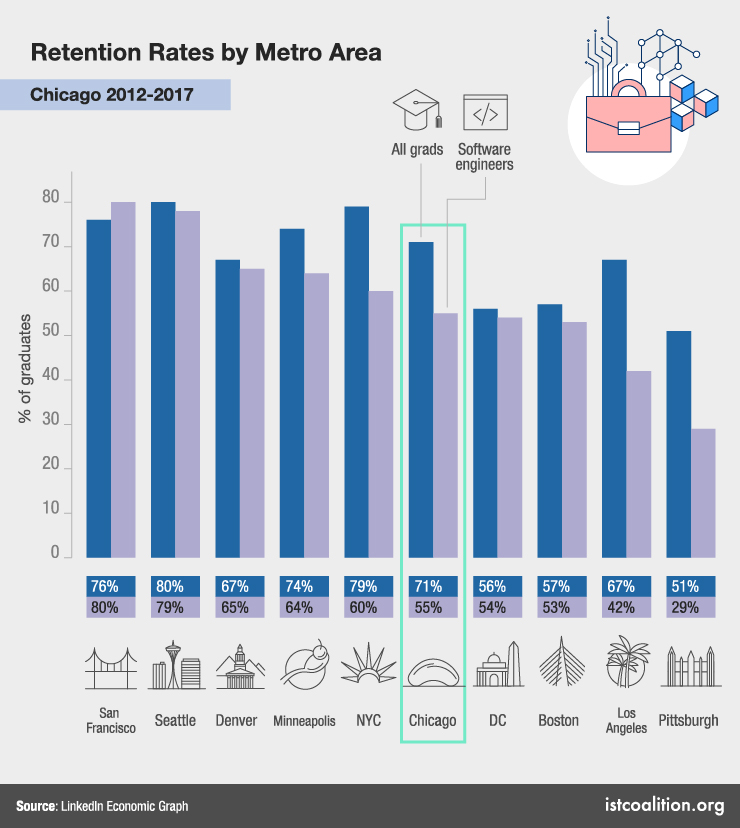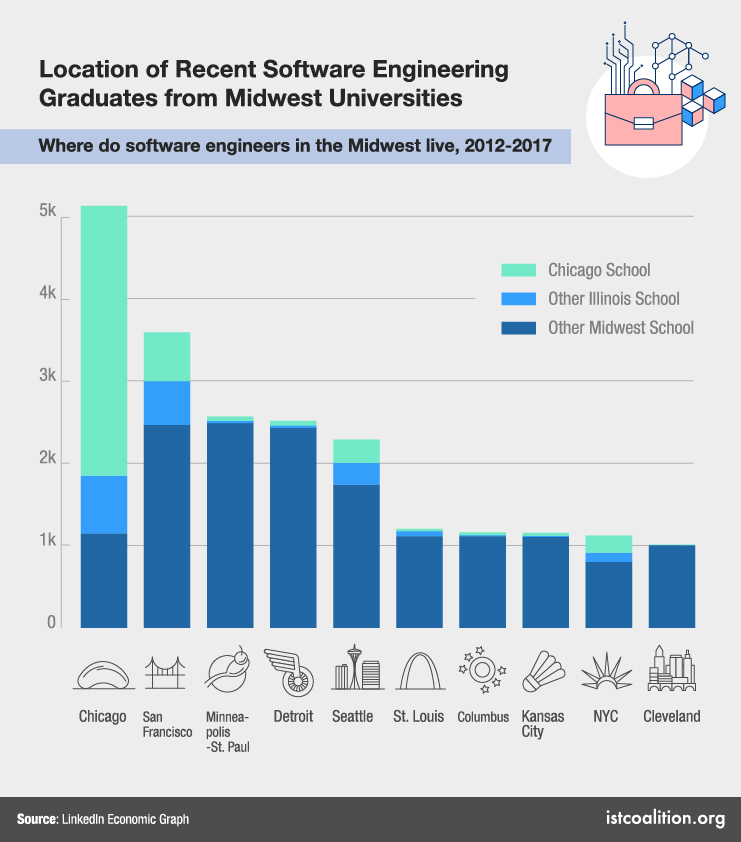STEM, Computer Science Degrees Reach Record High
Computer science degrees double over the last five years
| Download Full Index | Download Findings Onepager |
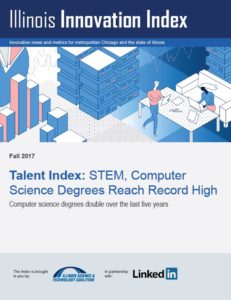 |
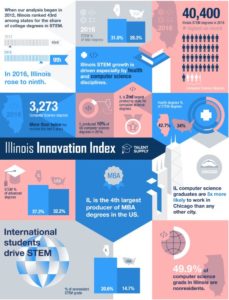 |
Contents
- Executive Summary
- Key Findings
- Supply: STEM degrees reach record high
- Nonresident students driving STEM talent growth
- In-Depth Analysis: Computer science degree growth and retention
- Demand: STEM jobs catching up to the national average
- Skills in demand, migration patterns in Chicago
- Talent retention, job market for Chicago’s software engineers
- Moving Forward
Full Index methodology can be found here.
Executive Summary
When our analysis of STEM talent began five years ago, the state lagged the national average for degree production, ranking 43rd among states for the share of college degrees awarded in STEM disciplines. In 2016, Illinois rose to ninth. This transformational growth, especially in health and computer science disciplines, has positioned the state as a national leader for STEM talent.
Computer science (CS) degrees have seen unprecedented growth in Illinois, reaching a record high in 2016. The state has more than doubled its production of CS degrees over the last five years, and is the second largest producer in the country. Aiding this growth is the number of international and immigrant students in the field. A staggering 49.9 percent of CS degrees were awarded to international and immigrant students in 2016.
Illinois’ share of STEM jobs lags the national average, but the state is closing the gap — with growth in these jobs outpacing the national average over the past five years. This growth is especially strong in computer-related fields, where growth has exceeded five percent annually. Overall, STEM jobs closely mirror the state’s talent production, with health and computer occupations most prevalent.
This year, thanks to insightful data from LinkedIn, the Index takes an in-depth look at Chicago’s software engineering workforce. One of the most in-demand jobs in today’s economy, software engineers design and build the software used in nearly every corner of the economy. The market for software engineering talent in Chicago is unique, with professionals working in a wide variety of industries and staying with their employers longer than in other regions. Though the city loses talent to industry hotbeds like San Francisco and Seattle, Chicago retains more talent than most cities, and is the top destination for software engineers in the Midwest.
Key Findings
Supply
- In 2016, Illinois produced a record 40,400 STEM degrees, representing 31.8 percent of all Illinois graduates, compared with 28.3 percent nationally. STEM talent production in Illinois continues to outpace the nation, growing 10.6 percent annually from 2012 to 2016, compared with 6.5 percent annual growth nationally. Illinois was the fourth fastest growing state for STEM degrees over that period.
- Computer science degrees continue to rise at an unprecedented rate, with the state awarding nearly 3,300 degrees in 2016, more than ever before in the field. Illinois is the second largest producer of computer science degrees nationally, awarding 9.9 percent of the nation’s CS degrees, despite awarding just 4.4 percent of the nation’s degrees overall.
- LinkedIn data show Illinois’ computer science graduates are five times more likely to work in Chicago than any other city in the country, and nearly half of all CS graduates remain in Illinois. The largest employers of Illinois’ CS graduates include Nokia, Allstate, State Farm, and Discover.
- International and immigrant students play a critical role in the national STEM talent pipeline, but occupy an even more pronounced role in Illinois. Overall, these students account for 35.1 percent of non-health STEM degrees and a staggering 49.9 percent of all computer science degrees awarded in the state.
- Illinois’ STEM degree growth has also been driven by health disciplines, which have grown by more than 20 percent annually over the past five years. The growth of health degrees has been accelerated by online degrees, which have risen sharply in recent years.
- Despite the growth of Illinois’ STEM talent production overall, the state must do more to promote diversity and inclusion within the STEM talent pipeline. Illinois trails the national average for the share of STEM degrees awarded to female, Hispanic or Latino, and African-American students. This is especially true in computer science, where just 16.7 percent of grads are female, while only 3.8 percent are Hispanic or Latino, and 2.5 percent are African-American.
Demand
- As a percentage of the overall workforce, Illinois’ STEM jobs slightly trail the national average. In 2016, 12.2 percent of Illinois workers were employed in STEM or STEM-related occupations (around 710,000 jobs), compared with 12.7 percent nationally.
- Though Illinois slightly trails the nation in STEM jobs, the state is closing the gap. From 2012 to 2016, STEM occupations grew by 2.7 percent annually in Illinois, compared with 2.3 percent nationally. Non-health STEM occupations are growing even faster, with 3.9 percent annual growth over the same period in Illinois, compared with 2.5 percent nationally.
- The largest STEM occupations in Illinois mirror the state’s talent production, with nine of the state’s top ten occupations in either health or computer-related occupations.
- Computer-related occupations are growing more quickly in Illinois than nationally, with annual growth of 5.1 percent in the state, compared with 3.9 percent nationally. Of these occupations, growth is strongest for information technology positions — such as computer systems analysts, user support specialists, and systems managers and administrators.
- Data from LinkedIn show in-demand software engineers work in a wide variety of industries, and tend to stay with their employers longer in Chicago than in other tech hubs. Despite professionals leaving for San Francisco, Chicago retains more talent than most cities, and is the top destination for professionals from the Midwest.
Supply: STEM degrees reach record high
The share of students graduating with STEM degrees[1] continues to grow rapidly in Illinois. In 2016, 31.8 percent of all bachelor’s, master’s, and doctoral degrees were awarded in STEM disciplines (approximately 40,400 degrees), compared with 28.3 percent nationally. The growth of STEM degrees in Illinois has significantly outpaced the nation over the past five years, growing 10.6 percent annually from 2012 to 2016, compared with 6.5 percent annual growth nationally. The share of non-health STEM degrees is also growing in Illinois, closing the gap compared to the nation. Non-health STEM degrees accounted for 18.2 percent of all degrees in 2016, compared with 18.7 percent nationally.
The tremendous growth of STEM degree production in Illinois has largely been driven by health disciplines, which grew by 20.2 percent annually from 2012 to 2016, compared with 7.5 percent annual growth nationally. Though not unique to health, growth in degree production has been accelerated by online degrees, which have risen sharply in recent years. Significant growth has also taken place in computer science and engineering disciplines, which have grown by 9.7 and 7.4 percent annually over the past five years. Overall, STEM degrees awarded in Illinois are more heavily weighted toward health and computer sciences disciplines. Though Illinois ranks sixth by overall graduates, the state is the third leading producer of degrees in STEM-health disciplines, and the fourth leading producer degrees in computer sciences disciplines.
STEM degrees in Illinois are also more heavily weighted toward graduate degrees; 31.3 percent of all STEM degrees are awarded at the master’s level, compared with 25.8 percent nationally. Health (36.3 percent), computer science (26.6 percent), and engineering (18.7 percent) disciplines make up more than 81 percent of all STEM master’s degrees awarded in Illinois. Master’s in computer science disciplines significantly outpace the nation, accounting for 26.6 percent of STEM master’s degrees in Illinois, compared with 19.0 percent nationally.
Illinois universities employ nearly 2,400 postdoctoral researchers in STEM disciplines — ranking seventh nationally — while Illinois’ federal labs employ nearly 400 additional postdocs. A highly skilled pool of STEM talent, postdocs are increasingly applying their skills in the private sector and towards entrepreneurial endeavors. The state is also the fourth leading producer of MBAs nationally, with 16.1 percent of all master’s degrees awarded as MBAs, compared with 14.2 percent nationally.[2] Though not a traditional STEM degree, those with business acumen can be critical when paired with STEM talent to commercialize innovation and scale businesses.
Demographically, STEM graduates in Illinois are largely similar to all graduates. In 2015, 55.9 percent of STEM graduates were female, slightly less than the 57.8 of all graduates in Illinois. However, when STEM-health degrees are removed, the share of degrees awarded to female students drops to 33.2 percent — lower than the national average of 35.9 percent. In 2015, 58.3 percent of Illinois’ STEM graduates were white; 10.1 percent Asian or Pacific Islander; 8.0 percent African-American; 7.1 percent Hispanic or Latino; and 16.3 percent temporary residents.[3] Both in Illinois and nationally, computer science graduates are significantly less diverse. Only 16.7 percent of computer science degrees were awarded to female students in 2015, while just 3.8 percent of CS graduates were Hispanic or Latino, and 2.5 percent were African-American — compared with 6.0 Hispanic or Latino, and 3.6 percent African-American, nationally.
Growing diversity among Northwestern engineers
Northwestern University’s School of Engineering and Applied Science has seen tremendous growth in the number of female and underrepresented minority doctoral students. In 2016, Northwestern was second among the US News and World Report Top 25 engineering programs in percentage of female doctoral students (29.5 percent). At the undergraduate level, roughly a third of engineers are women, far exceeding national averages. The resulting community of women engineers has earned national recognition. In 2017, the Society of Women Engineers honored Emily Hoffman as Collegiate Member of the Year. Hoffman earned a PhD in Materials Science and Engineering and is now a life sciences consulting associate for Charles River Associates.
Nonresident students driving STEM talent growth
Illinois’ economy is in a unique position to capitalize on foreign-born talent. The strength of Illinois’ universities, especially in STEM, attracts students from around the world. The share of STEM degrees awarded to nonresident students is far higher in Illinois than nationally.[4] In 2016, 20.6 percent of all STEM degrees were awarded to nonresidents, compared with 14.7 percent nationally. When STEM-health degrees are removed, nonresidents make up an even larger share — 35.1 percent of non-health STEM degrees, compared with 21.2 percent nationally. In computer science, 49.9 percent of all degrees are awarded to nonresidents, up from around 37.3 percent in 2012. This staggeringly high percentage of nonresident graduates in an in-demand field illustrates the need for retaining this talent within the state.
In light of the high share of STEM degrees awarded to nonresidents in Illinois, the state is uniquely positioned to benefit from changes to federal immigration policy. While comprehensive immigration reform would provide the most benefit to the state, there are several policy changes on the federal agenda that stand to impact Illinois’ economy. The most high-profile of these policies is Deferred Action for Childhood Arrivals (DACA) — the program recently rescinded by the Trump administration that gives temporary legal status to previously undocumented immigrants brought to the United States as children (often referred to as “Dreamers”). DACA has allowed nearly 800,000 immigrants to go to college, work, and contribute to the economy without fear of deportation.[5] Without a replacement, many of Illinois’ 42,000 DACA recipients would lose their jobs, costing the state as much as $2.3 billion in lost GDP annually.
In addition to DACA, the recently introduced Startup Act (S. 1877) includes changes to federal immigration policy that would provide a boost to Illinois’ economy. First, the Startup Act implements the International Entrepreneur Rule (sometimes known as the Startup Visa), which would provide a clear pathway to residency for foreign-born founders growing their businesses in the United States. By encouraging innovators to bring their new ideas, expertise and unique skills to the U.S., it’s estimated the rule would add between 135,000 and 308,000 jobs nationally over the next decade. The Startup Act would also make more visas available for high-skilled STEM professionals. Beyond directly boosting the state’s STEM talent pool, adding foreign-born STEM talent to the workforce provides additional employment for US citizens. In fact, adding an additional 100 immigrants with advanced degrees in STEM fields from either US or foreign universities is associated with an additional 86 jobs among U.S. natives.[6]
Loyola University Chicago embraces Dreamers
Through its inclusive programs and support, Loyola University Chicago has become a national destination for Dreamers. The Loyola University Chicago Stritch School of Medicine was the first medical school in the country to openly welcome students with DACA status in 2014 — and now has more of these students than any other medical school in the nation. Loyola also provides the support Dreamers need to successfully complete their education and enter Illinois’ workforce. Since these students are not eligible for most federal loan benefits, Loyola has partnered with the Illinois Finance Authority to provide loan assistance to DACA students. These interest-free loans require the recipient to provide a year of service in a designated underserved area of Illinois for each year he or she receives the loan. Thanks to Loyola’s commitment to inclusiveness, Dreamers from around the country are choosing to study in Illinois, before applying their expertise in the state’s underserved communities.
In-Depth Analysis: Computer science degree growth and retention
With an increased focus on cloud computing, big data, IoT, and mobile computing, the importance of computer science talent in the economy continues to grow. Those with computer science skills are some of the most sought-after members of the workforce, with around half a million computer and information technology jobs expected to be added nationally by 2024.[7] Thanks to an intentional focus on growing computer science programs at in-state universities, Illinois is producing more CS graduates than ever before.
Illinois’ computer science talent production reached an all-time high in 2016, with 3,273 bachelor’s, master’s, and doctoral CS degrees awarded — easily surpassing the state’s previous high of 2,584, recorded in the wake of the dot-com bubble in 2003.[8] This growth of CS degrees in Illinois is unprecedented, more than doubling in the last five years. Fueled by the growth of nonresident students, CS degrees in Illinois have grown by 19.1 percent annually since 2012, outpacing national growth of 18.4 percent. This growth has made Illinois the second largest producer of computer science degrees nationally, despite ranking sixth for all graduates.
Given the volume of computer science graduates coming out of Illinois’ universities, it’s critical for the state retain this talent to foster economic growth. Despite the perception that much of this talent leaves the state for industry hubs like San Francisco or Seattle, analysis of LinkedIn data suggests the state is retaining a significant portion of graduates. Chicago is by far the most likely destination for Illinois’ CS graduates, with more than 25,000 in the Chicago-area — five times more than second-placed San Francisco. Overall, around half of Illinois’ CS graduates remain in the state.
Despite the significant proportion of CS graduates staying in the state, Illinois lacks large volume employers like Google, Microsoft and IBM. Instead, Illinois CS graduates are dispersed among a number of smaller employers in a more diverse cross-section of industries, including finance, insurance, and telecommunications. The largest employers of Illinois’ CS graduates in-state include Nokia, Allstate, State Farm, and Discover.
Demand: STEM jobs catching up to the national average
While the state’s production of STEM talent has surpassed the national average, Illinois’ share of jobs in STEM has lagged the nation. In 2016, 12.2 percent of Illinois’ workforce was employed in STEM (around 710,000 jobs), compared with 12.7 percent nationally. However, the state is closing that gap. Over the past five years, STEM jobs in Illinois have grown more quickly than the national average, with annual growth of 2.7 percent, compared with 2.3 percent nationally. Illinois’ STEM job growth is more pronounced when STEM-related (primarily health occupations) are removed, with 3.9 percent annual growth in these core STEM jobs over the past five years, compared with 2.5 percent annual growth nationally.
Health and computer-related jobs account for nine of the top 10 STEM and STEM-related occupations by share of the overall workforce. Health occupations include registered nurses, licensed practical and vocational nurses, and pharmacy technicians, while top computer occupations include computer systems analysts and software developers, among others. Compared to the nation, several computer and systems support positions (commonly referred to at IT positions) are growing significantly more quickly in Illinois. These include computer systems analysts, user support specialists, and systems managers and administrators.
Matching the growth of computer science graduates discussed earlier, several of the fastest growing STEM jobs in Illinois are computer-related occupations, such as web developers, computer network support specialists, and computer systems analysts. Overall, employment in computer-related fields is growing more quickly in Illinois that nationally, with annual growth of 5.1 percent, compared with 3.9 percent nationally.[9] The fastest growing STEM occupation in Illinois is operations research analysts, which use STEM skills such as data-mining and statistical analysis to help businesses operate more efficiently. Thanks to the state’s production of STEM talent and traditionally strong business-services sector, employment in these jobs have more than quadrupled over the last five years — growing from around 1,800 in 2012, to 8,400 in 2016.
Skills in demand, migration patterns in Chicago
The skill makeup of Chicago’s workforce largely reflects broader economic trends in the area. The most abundant skills in Chicago correspond to many of the city’s traditional industries, such as finance, investing, and business services. Several STEM skills are among the scarcest in Chicago, including computer-related and programming skills, as well as those in environmental science and healthcare.[10] The scarcity of computer-related skills, along with evidence that such fields are growing, confirms the need for the Chicago to retain and attract more of these professionals.
Migration patterns to and from Chicago remain largely unchanged from last year’s analysis. Chicago attracts talent regionally, with the largest influx coming from in-state Urbana-Champaign; Bloomington-Normal; and Peoria. Outside the state, Chicago gains the most talent from Cincinnati; Columbus, Ohio; and Pittsburgh. Chicago also exports talent nationally. The top destinations are San Francisco; Denver; and Los Angeles.
Strategies for retaining Illinois’ STEM talent
Keeping more of Illinois’ STEM graduates in the state will take intentional effort from universities, employers, and other stakeholders. For universities and employers, establishing strategic internship programs is one way of developing an in-state talent pipeline. Engineering at the University of Illinois represents a strong case study for establishing internship pipelines. At the University of Illinois at Urbana-Champaign (UIUC), 70 percent of undergraduate engineering students complete internships prior to graduation. Among those that complete internships, 50 percent receive a full-time job offer as a result.[11] Increasingly, internships are completed during the school year, allowing students to work 10 to 20 hours per week, gaining real-world experience while completing their degrees. Illinois companies employing UIUC students during the school year include: Abbvie, Abbott, ADM, Brunswick, Caterpillar, CME Group, Country Financial, Grainger, John Deere, Jump Trading, Littelfuse, and State Farm. The success of UIUC’s internship partnerships has led to the university launching its City Scholars program, which facilitates students living and working in Chicago, while completing UIUC coursework. The University of Illinois at Chicago (UIC) is also connecting students with employers, offering qualifying freshman a guaranteed paid internship within industry or university research labs following their freshman year. Thanks to this effort, more than one-third of UIC engineers graduate with two or more internship experiences.
Beyond university and employer efforts, several Illinois organizations are working to improve the state’s STEM talent workforce. ThinkChicago — an initiative of Chicago Mayor Rahm Emanuel, along with the University of Illinois System, World Business Chicago, and Chicago Ideas Week — brings some of the brightest engineering, design, and entrepreneurial university students to Chicago with the goal of retaining and attracting talent from throughout the country to increase job growth in Chicago’s technology industry. Similarly, the Illinois Technology Association’s (ITA) annual Tech Challenge brings programmers from around the country to Chicago, where they compete in coding challenges and interview with the city’s top tech companies. The Illinois Science & Technology Institute (ISTI) also creates connectivity between Illinois employers and students at the high school level through its STEM Challenges, which allow high school students to work with STEM professionals on real-world projects.
Talent retention, job market for Chicago’s software engineers
Recent LinkedIn analysis sheds light on the job market for software engineers in Chicago, as well as the region’s ability to retain and attract this talent. Software engineering is a core occupation in computer science, with professionals in the field designing and building the software that has become integral in nearly every industry. According to LinkedIn, there are approximately 41,000 software engineers working in the Chicago-area, making it the seventh largest market for these professionals. However, based on recruiter activity on LinkedIn, Chicago software engineers are among the most in-demand, ranking fifth nationally.
Software engineers in Chicago work in a wide variety of industries. Beyond software & IT services (about 16,000 jobs), Chicago’s software engineers are most likely to work in finance (5,500 jobs) and healthcare (3,100 jobs). Top employers in the Chicago-area include Motorola Mobility, Allstate, Accenture, Tata Consulting Services, IBM, Sears Holdings Corporation, Nokia, and Motorola Solutions. When compared to other major metros, software engineers in Chicago tend to stay with one company longer. Among the 10 largest U.S. cities, Chicago has the third longest average tenure for software developers, 29 percent longer than the San Francisco Bay Area.
To grow Chicago’s access to software engineers, it must work to retain talent produced in the region. Though Chicago is among the top regions for retaining all graduates — 71 percent of recent graduates remain in the area — only 55 percent of Chicago’s software engineers remain after graduation.[12] However, this phenomenon is not unique to Chicago. Though the area retains fewer software engineers compared with other graduates, it’s retention rate is above average nationally. Among the 50 largest US cities, Chicago is tied for 15th for retaining software engineering graduates.
Given the national demand for software engineers, and their propensity to relocate, it’s also critical for Chicago to attract talent from other regions. Chicago is the top destination for recent software engineering graduates from the Midwest, followed by San Francisco and Minneapolis-St. Paul. However, software engineers educated at top universities in the Midwest are more likely to leave the region, with San Francisco the most likely destination. The attraction for recent software engineering graduates to San Francisco isn’t unique to Chicago. The Bay-Area is a top three destination for recent software engineering graduates from the every region of the country.
Uptake’s novel approach to talent
Chicago-based company Uptake uses data science and machine learning to provide predictive analytics to its clients. By using data science to upend the traditional business services model, Uptake has grown into a company valued at over $2 billion since its founding in 2014. Fueling this growth has been the company’s ability to attract talent, especially those with computer or data science skills.[13] Uptake uses unique recruiting methods to find applicants with programming and development skills. In 2017, the company launched its #UptakeChallenge, a recruiting effort in the form of an interactive, code-based puzzle displayed at Chicago bus stops. Participants who successfully completed the multi-step challenge were invited to a celebration at Uptake, and several qualified candidates were hired by the company. Uptake also attracts talent from outside the traditional university-industry pathway, including hiring candidates from bootcamps that teach programming, software development, and data science skills. Bootcamps have become a valuable addition to the talent pipeline for Uptake, teaching in-demand skills to professionals on non-traditional career paths.
Moving Forward
Driven by dramatic gains in health and computer science disciplines, the growth of STEM degree production in Illinois has been unprecedented. Over the last five years, the state has gone from trailing the national average to becoming a national leader in STEM degree production. The growth of computer science in Illinois has been especially encouraging given the critical role this talent will play in the economy over the coming decades. This growth presents a tremendous opportunity for Illinois’ economy, which has lagged the national average for jobs in STEM fields. To increase access to STEM talent, the state must look to capitalize on nonresident students at in-state universities through support of federal policy that would allow this talent to stay and work in the state. Illinois’ universities should also look to partner with employers to create internship opportunities for their students, which have been shown to increase graduate retention. Lastly, with STEM skills becoming more widespread within the modern workforce, the state should look to further incorporate its STEM talent into traditional industries of strength.
[1]
Index methodology includes a full list of STEM degrees
Illini Success: College of Engineering Report, University of Illinois at Urbana-Champaign, 2016.
Archive
2016 – Talent Index
A comprehensive look at STEM degrees, talent migration, and skills in demand
2015 – Talent Index
New analysis sheds light on STEM talent supply and demand in Illinois
2014 – Talent Index
Illinois sees continued growth in high-tech businesses and jobs
2014 – Talent Index
STEM attainment in Illinois and talent migration trends in Chicago
2013 – Talent Index
Business climate in Illinois and metropolitan Chicago: Indicators and recent trends
2013 – Talent Index
Talent in Illinois and Chicago: Data and recent trends

